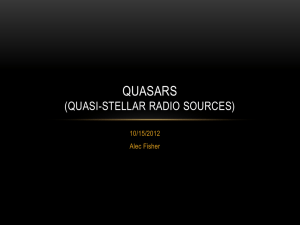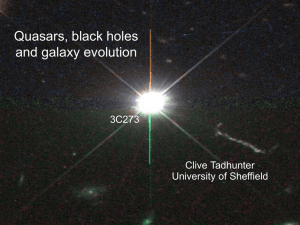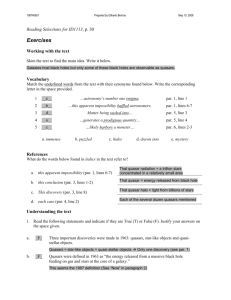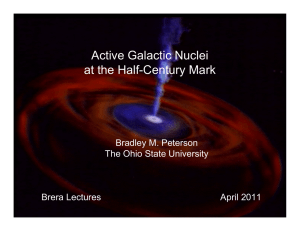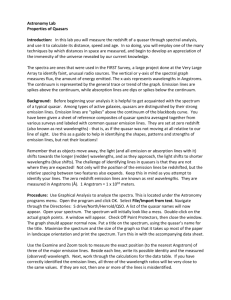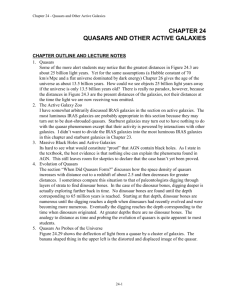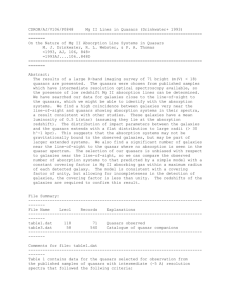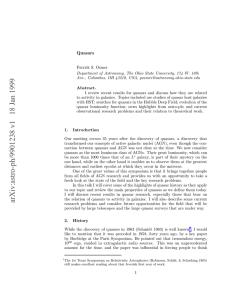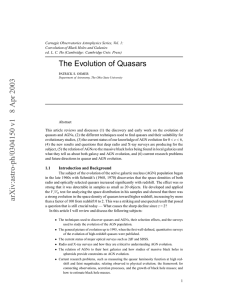Black Hole Demographics
advertisement
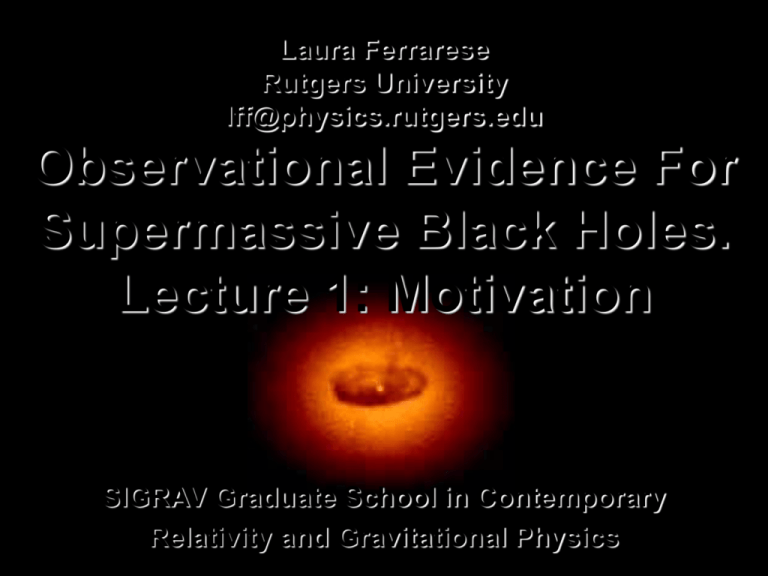
Laura Ferrarese Rutgers University lff@physics.rutgers.edu Observational Evidence For Supermassive Black Holes. Lecture 1: Motivation SIGRAV Graduate School in Contemporary Relativity and Gravitational Physics Lectures Outline Lecture 1: Introduction and Motivation Lecture 2: Stellar Dynamics Lecture 3: Gas Dynamics Lecture 4: AGNs and Reverberation Mapping Lecture 5: Scaling Relations Lecture 6: What the Future Might Bring ALL LECTURES ARE ON-LINE: http://www.physics.rutgers.edu/~lff/Como Username: como Password: sigrav & http://dipastro.pd.astro.it/bertola/astrofisica.html Lecture 1: Outline Motivation: Why Do We Think Supermassive Black Holes Exist, and Where Should We Look if We Wanted to Find One? The Mass Density in the Supermassive Black Holes Powering Quasar Activity The Mass Density in the Supermassive Black Holes Powering Local AGNs Supermassive Black Hole Detections Historical Overview Although unrealized at the time, the first hint of the existence of supermassive black holes was unveiled with: Karl Jansky’s 1932 discovery of radio emission from the Galactic center. Carl Seyfert’s 1943 discovery of the peculiar spiral galaxies which today carry his name. By the 1960, several hundred radio sources had been discovered, and astronomers were struggling to find optical counterparts. In 1960, Allan Sandage identified 3C48 with a single blue point of light. In the two years after Sandage’s discovery of the optical counterpart to 3C48, a half dozen such objects were discovered; to distinguish them from radio galaxies, for which the optical emission is clearly resolved, objects like 3C48 were named quasi stellar radio objects or quasars. 3C 48 Karl Jansky Historical Overview Ground based optical images of 3C273 Optical jet Hubble Space Telescope images of 3C273, revealing the underlying galaxy Quasars The spectral energy distribution of quasars (and AGNs in general) is markedly non-stellar. SED for 3C273: green: contribution from the outer jet blue: contribution from the host galaxy. http://obswww.unige.ch/3c273/ Quasars The night after observing the optical counterpart to 3C48, Sandage took a spectrum, which he described as “the weirdest spectrum I had ever seen”. The spectrum had several emission lines, but none seemed to correspond to known elements. The impasse was broken by Maarten Schmidt in 1963. Schmidt realized that the emission lines in the spectrum of 3C273, were the very familiar hydrogen Balmer lines, but redshifted by v/c = 0.158. It was soon realized that all quasar spectra could be interpreted this way. Although controversial for a long time, it is now recognized that quasar redshifts are cosmological. Optical Spectrum of 3C273 QuickTime™ and a TIFF (Uncompress ed) decompress or are needed to s ee this picture. Maarten Schmidt Quasars 3C273, and all quasars, show flux variability on timescales of hours to months (depending on the frequency) 3C273: http://obswww.unige.ch/3c273/ Quasars ENERGY OUTPUT: At cosmological distances, quasars must be hundreds to many tens of thousand times more luminous than an L* galaxy. In general, AGNs bolometric luminosity are of order 1044-1048 erg s-1 In the Eddington approximation, this implies masses LE = 4 GMBH mp/T; and assuming a typical quasar lifetime of order 107 yr MBH > 106 M SIZE: The time variability sets very tight limits on the size of the emitting region, which A A Brightness must be smaller than the distance light can travel in that time: Even if the brightness changes at every point simultaneously, the change happening at point A would reach us sooner than the change from point B. It will take the time for light to travel from point B to point A for an observer to perceive the full change. B B A B A B Time This implies that the emitting region is less than a few light weeks or days across. Combined with the constraints on the mass, the implied central densities are of order 1015 Mpc-3 Quasars COHERENCE: jet stability and collimation over hundred of kiloparsecs in some objects imply a stable energy source. ~ 1Mpc QuickTime™ and a TIFF (Uncompressed) decompressor are needed to see this picture. AGNs RELATIVISTIC MOTIONS: one of the greatest surprises provided by very-long baseline interferometry (VLBI) observations was the fact that some AGNs exhibit motion along their jets with speeds which appear to be several times faster than light. Sequence of HST images showing blobs in the M87 jet apparently moving at six times the speed of light. The slanting lines track the moving features. 5000 light years Energetics, sizes, densities, coherence, and the presence of relativistic motions imply that the power supply is gravitational; central engines are relativistic, massive, compact and good gyroscopes. A massive black hole is the inevitable end result of nuclear runaway From Rees 1984, ARA&A 22, 471 The Relativistic Region Evidence for a Strong Field Regime: 6.4 keV Fe K emission is the most compelling case of the existence of an accretion disk at 3-10Rs from a central BH (Fabian et al. 1989, 1995; Nandra et al. 1997, Iwasawa et al. 1999). Line widths reach 105 km s-1 Potential way to constrain: 1) spin of the BH; 2) accretion rate; 3) central mass (Fabian et al. 1989, Martocchia et al. 2000) 0.3 c Composite Spectrum of 18 AGNs observed with ASCA (Nandra et al. 1997) Where to Look: Punchline Quasars were much more common in the past: the “quasar” era occurred when the Universe was only 10-20% of its present age. Simple arguments indicate that the cumulative mass density in supermassive black holes powering quasar activity is of order BH(QSO) ~ 3 - 4 105 M Mpc-3 However, the mass density in supermassive black holes at the centers of local AGNs is a full two order of magnitudes lower! Where have the quasars gone? The bulk of the mass connected with the accretion in high redshift QSOs does not reside in local AGNs. Remnants of past activity must be present in a large number of quiescent galaxies. Where to Look Our journey into SBH demographics stars from quasars: let’s try to follow their evolution from the study of the luminosity function (number of quasars per unit comoving volume). LOW REDSHIFTS (z < 2.3) (Boyle et al. 2000, MNRAS, 317, 1014): The 2-degree field QSO Redshift survey includes redshifts for > 25000 18.25<B<20.85 QSOs in two 75° ××5° declination strips in the South Galactic Pole and in an equatorial region at the North Galactic cap. Data were collected using the AAT Two-Degree Field (2dF) multi-object spectrographic system, which allows up to 400 spectra to be obtained at once. http://www.aao.gov.au/2df/ http://www.2dfquasar.org/ HIGH REDSHIFTS (z > 3.5) (Fan et al. 2001, AJ, 121, 54): The Sloan Digital Sky Survey First Data Release includes photometric data based on five-band imaging observations of 2099 square degrees of sky. Based on these photometric data, spectra were obtained for 150,000 galaxies and quasars. The survey will ultimately cover 1/4 of the sky, and is currently 65% complete for imaging, and 44% complete for spectroscopy. http://www.sdss.org/ The 2dF Quasar Survey Completeness QSO distribution THe SDSS Quasar Survey The LF is derived from 39 luminous QSOs over the range 3.6<z<5.0, and -27.5<M1450<-25.5. The luminous quasar density decreases by a factor of ~ 6 from z =3.5 to z =5.0. The luminosity function at the bright end is significantly flatter than the bright end luminosity function found at z<3, suggesting that the quasar evolution from z=2 to z=5 cannot be described as pure luminosity evolution (Fan et al. 2001, AJ, 121, 54). The survey has also detected 4 quasars at redshift > 6, including the current record holder at z=6.48 (Fan et al. astro-ph/0301135) SBHs in High Redshift Quasars Fan et al. 2001, Boyle et al. 2000 QSO Mass Function (0.3 < z < 5) (Soltan 1982, MNRAS, 200, 115; Chokshi & Turner 1992, Small & Blandford 1992, Salucci et al. 1998…) 1) Luminosity Function (L,z) (z)(L/L(z)) 2) Integrated comoving energy density radiat ion L(L, z)dL 0 0 d dz dz 3) Integrated comoving mass density BH 10 rad 0.1c 2 K QSO ( M) bol2 c 0 L L' (L',z) H 0 (1 z) m (1 z) 3 dL'dz SBHs in High Redshift Quasars Ferrarese 2002 (astroph/0203047) A note of caution: The magnitude limits of the 2dF and SDSS samples correspond to Eddington limits on the masses of 4.5107 M and 7.3108 M respectively. The quasar LF has no coverage in the 2.3 < z < 3.0 redshift range. See also Yu & Tremaine 2002 (MNRAS 335, 965) SBHs in Local AGNs Local AGN Mass Function (0 < z < 0.2) (Padovani et al. 1990, ApJ, 353, 438) Need a way to estimate MBH in a complete sample of galaxies: Assume that the BLR clouds are gravitationally bound: MBH=v2r/G with r = size of the Broad Line Region measured from Reverberation mapping (Blandford & McKee, Peterson 2001) Photoionization methods (Padovani et al. 1990; Wandel Peterson & Malkan 1998) The bulk of the mass connected with the accretion of high z QSOs does not reside in local AGNs. Remnants of past activity must be present in a large number of quiescent galaxies How to Do It How can we constrain the masses of supermassive black holes? naively, we might think that the presence of a SBH will create a cusp in the brightness profile of the host galaxy. It does, but….. From Kormendy & Richstone 1995, ARAA, 33, 581 How to Do It Phenomenon: Quiescent Galaxies Type 2 AGNs Type 1 AGNs Primary Methods: Stellar or gas dynamics Water Megamasers Reverberation Mapping NGC4261 - HST/WFPC2 NGC205 - HST/ACS/HRC - 29X29 arcsec NGC4258 (Seyfert 2) Detections of SBHs in the Local Universe Implied density (M pc-3) SBH Mass (M) Innermost radius probed Reverberation Mapping Three dozen Seyfert 1s and quasars 5 106 to 5 108 a few light days ~1012 Stellar Kinematics (proper motion): Milky Way 3.7 106 0.008 pc 1 1017 Water Masers: Type 2 AGNs (NGC 4258 & Circunus) 4 107 0.13 pc 1 1012 4 107 to 4 109 >0.4 pc, but typically>3.5pc < 1 107, typically 104 Method Kinematics of gas disks: 9 galaxies, mainly large ellipticals with low luminosity AGNs Stellar kinematics: 10 galaxies, mainly smaller, rotational supported ellipticals Detecting Supermassive Black Holes in Local Galaxies With the exception of the Iron K observations, every other technique used to measure supermassive black holes masses probes regions well beyond the strong field regime. Source X-Ray Fe K Broad-Line Region Proper Motion (MW) Megamasers Gas Dynamics Stellar Dynamics Distance from central source 3-10 RS 600 RS 2000 RS 4 104 RS 8 105 RS 106 RS In units of the Schwarzschild radius RS = GM/c2 = 1.5 1013 M8 cm . Preview: Scaling Relations Suggested Readings Iron Kapha Line: Reynolds & Nowak 2003, astro-ph/0212065 SBH Demographics: Soltan 1982, MNRAS, 200, 115 Ferrarese 2002, in ‘Current high-energy emission around black holes’, Eds by C.-H. Lee and H.-Y. Chang. Singapore: World Scientific Publishing, p.3, astro-ph/0203047 Yu & Tremaine 2002, MNRAS, 335, 965 Quasar Luminosity Function: Fan et al. 2001, AJ, 121, 54 Boyle et al. 2000, MNRAS, 317, 1014
